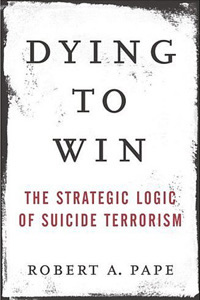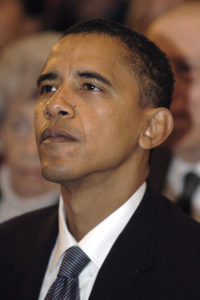Chicago in the News
The Chronicle’s biweekly column Chicago In the News offers a digest of commentary and quotations by a few of the University faculty members, students and alumni who have been headlining the news in recent weeks. Chicago faculty members are some of the most frequently quoted experts, so space allows publishing references to only selected examples. To read many of the full newspaper articles mentioned in this column, visit the In the News column at the University News Office Web site: http://www-news.uchicago.edu.
 |
|
What factors into the fuse?
Robert Pape’s research on suicide terrorism was cited in an article published Saturday, Feb. 9 in The Economist. Pape, Professor in Political Science and the College, has identified three factors that make suicide terrorism probable, the article noted. It is likely to occur when a community feels it is under occupation that must be resisted, when the “occupier” is a democratic society whose opinion can be swayed and where there is a sectarian difference between the perpetrators’ community and the target community. The article noted that although Pape believes religious differences help fuel suicide bombings, they are not the main driving force behind such acts of terrorism.
If the strategy fits
Scott Meadow, Clinical Professor of Entrepreneurship in the Graduate School of Business, and Linda Darragh, Adjunct Associate Professor in the GSB, were both quoted in a Monday, Feb. 11 Chicago Tribune story that examined entrepreneurs who are considering starting two businesses at the same time. “Look for a strategic link and a reason they fit together,” Darragh said, and do not base a new, second business on opportunity alone. Meadow noted that growing two companies at the same time could be difficult if investors are skeptical of second business’ success. “Unless I had Steve Jobs for both companies, I doubt I would consider backing someone who was working on two different deals,” he said, referring to the CEO of Apple.
Persuasive force of social mimicry
Jean Decety, Professor in Psychology and the College, who has studied empathy, was quoted in a New York Times story about the subtle cues that lead to positive rapport between people—especially when one person wants to persuade another person. The article established that many verbal and non-verbal cues can lead to good rapport between communicating individuals, and one particularly effective tool of persuasion is subtle, social mimicry. “When you’re being mimicked in a good way,” said Decety, “it communicates a kind of pleasure, a social high you’re getting from the other person, and I suspect it activates the areas of the brain involved in sensing reward,” he added.
Securitization and lax lending
Research by Atif Mian and Amir Sufi, both Assistant Professors in the GSB, was featured in the “Economics Focus” column of the Thursday, Feb. 7 edition of The Economist. The research found “hard evidence that securitization encouraged lax mortgage lending in America,” the article noted. Securitization fostered “moral hazard” among mortgage originators, which led them to issue loans to borrowers who were not creditworthy, according to the research. A separate study by Amit Seru, Assistant Professor in the GSB, also was cited in the article. His findings show that a loan portfolio that fits the criteria for securitization is far more likely to default than a similar package of loans with a slightly lower credit score that is less likely to be securitized.
Competitive successes
Student-athletes who attend the University Laboratory High School were in the High School Spotlight of the Wednesday, Feb. 13 Chicago Sun-Times’ sports pages. A story about their successes during recent years featured students who have made athletic strides in boys and girls soccer, track and field, tennis, boys swimming and girls cross country competitions, having won many regional and sectional titles. A photograph showed some of the current student-athletes on the Maroons’ teams at the high school. The article also highlighted famous alumni of the Laboratory High School, including Arne Duncan, CEO of the Chicago Public Schools, John Paul Stevens, U.S. Supreme Court justice, and Edward Levi, former U.S. Attorney General and President Emeritus of the University.
Chicago’s corporate landscape
Edward Snyder, Dean of the GSB and the George Pratt Shultz Professor of Economics in the GSB, was quoted in a Sunday, Feb. 10 Chicago Tribune article about the risks facing “corporate Chicago” as big-name companies cope with increasing financial pressure. “You would like to have big global headquarters, but in the end, the scorecard is based on the quality of the jobs,” he said. “We’re going to focus on a mix of companies and getting pieces of companies to move here, and not let the landscape be defined by a small number of top companies,” said Snyder, who also is a director of the World Business Chicago civic group.
 Photo by Dan Dry |
|
Political perpetuity
Robert Baird, a doctoral student in the Divinity School, wrote an essay that appeared in the Sunday, Feb. 3 edition of the Chicago Tribune about how the Kennedy family endorsement of Barack Obama is not only a boost for the Democratic presidential candidate, but also a way for the Kennedys to keep their family’s mystique alive. Baird applied T.S. Eliot’s argument about new art—“What happens when a new work of art is created is something which happens simultaneously to all the works of art which preceded it”— to a rising star in the political arena. Baird wrote, “It strikes me that the same is true in politics. How we think about the political past is determined in large part by how we think about the political present. I suspect the Kennedys know this. As much as any American family, they recognize that the past is the hostage of the present.”
Too good to be true?
A political commentary co-written by Richard Thaler, the Ralph and Dorothy Keller Distinguished Service Professor of Behavioral Science and Economics in the GSB, and his colleague Susan Woodward, was published in the Monday, Feb 4 issue of The New Republic. In the article, the two economists describe why they disagree with presidential candidate Hillary Clinton’s proposed plan to assist homeowners caught in the housing market’s mortgage crisis by freezing the monthly rate on adjustable rate mortgages for at least five years. “Senator Clinton’s proposal might appeal to homeowners with adjustable-rate mortgages scheduled for a rate increase. But, as with most offers that look too good to be true, this one comes with many problems,” they wrote. They argue that the proposal is too large in its scope and is applied too broadly to problems that are contained and specific.
![[Chronicle]](/images/sidebar_header_oct06.gif)